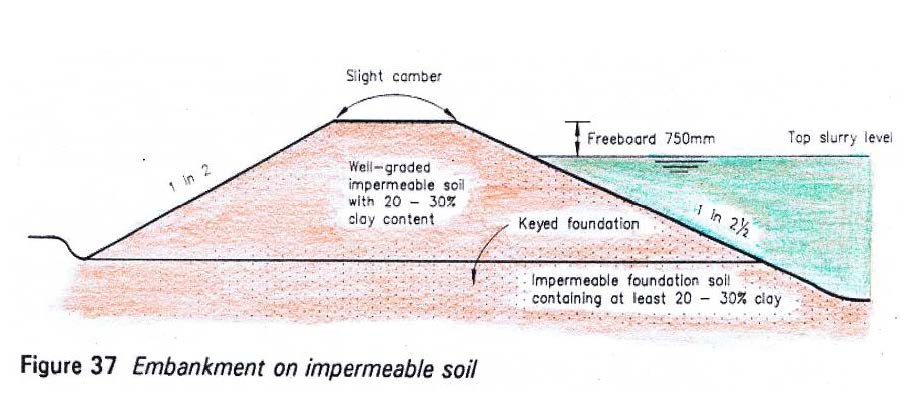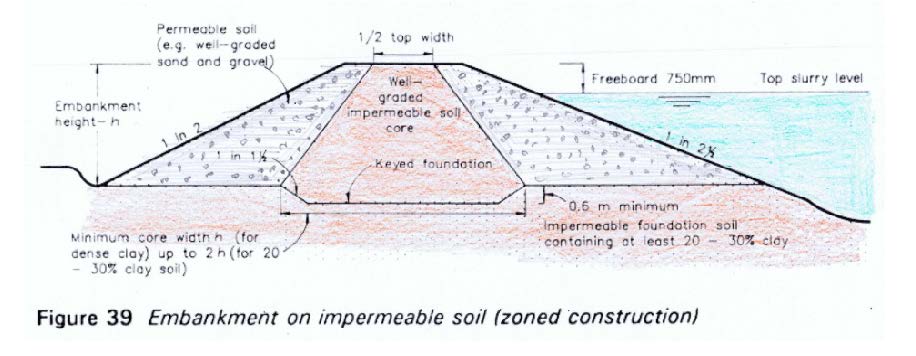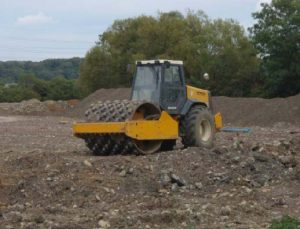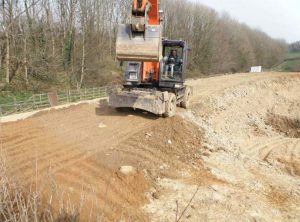Low cost storage
Would an earth lined lagoon suit your farm?
If you have a good site with suitable soils, then a properly constructed earth-lined lagoon can be an effective option for slurry storage, costing a third to a quarter to build than an equivalent concrete or steel store.
Getting started
The first step is to work out how much slurry you need to store, which you should have already done when filling in NVZ leaflet 4. Don’t forget to include yard runoff and any other fouled water that you direct to the store.
Then you can estimate how much area you will need to build a lagoon to hold it all. To give some idea of size, a lagoon to hold 5 months slurry from 150 cows might be 5 metres deep and be 35 x 35 metres along the inside top banks. This could occupy an area of 0.3 hectares (0.7 acres) overall.
The calculation allows for a 750 mm operating freeboard and 630 mm of rain falling into the lagoon, which would be typical in a 1,250 mm (50″) rainfall area.
Test pits
Now that you know how big the lagoon needs to be, it is time to get a digger in and excavate five test pits – one in the middle and one at each corner of the site.
The aim is to go down to a metre below final lagoon depth. On a level site, test pits 4-5 meters deep should suffice for final lagoon depths of up to 5 metres.
As you dig, lay the excavated soil down on the adjacent ground in sequence, as in the photo. Check and record clay and stone content in each layer.
Take photo records of the pit and removed soil. Fill each pit in immediately, to eliminate safety hazards.
Is your soil suitable?
The most suitable soils for lagoon construction have a 20-30% clay content, which give a suitably low permeability (10-9 metres per second, or 1″ per year) combined with high strength for stable embankments which do not crack when dry. These soils fall within the middle (blue) band in the soil texture diagram below.

Heavier clay soils (green area) are also suited to lagoon construction, provided that precautions are taken to prevent cracking or slumping.
Before you pay for laboratory permeability testing (£100 to £400 per sample), you can check the clay content of your soils for yourself, and establish their suitability for lagoon construction.


Wet up a soil sample to the consistency of plasticine while kneading it between your thumb and forefinger. If it moulds into a strong ball and smears but does not polish (left photo) it is a clay loam. If it feels very sticky when wet and polishes (right photo) it is a clay.
If your soils are too sandy or too stony, a plastic liner may be an option, though this could add 50% to the build cost, and steps need to be taken to prevent damage to the liner.
Lagoon construction
Various types of bank construction are possible, depending on the material available and the location of impermeable soil layers.


Two examples from the CIRIA 126 farm waste storage construction guidelines are shown above. In the second bank, the fine impermeable soil has been used for the core of the bank and the stonier material has been used on the bank sides.
General construction considerations are:
- The outsides of the embankments must be at least 10 metres from open drains and watercourses.
- Remove all trees, scrub, roots, and other unsuitable material.
- Remove topsoil from the site including the area of the embankments.
- Relocate any drains
- Level and compact the sub-soil to impermeable standards.
- Level embankment areas and provide a proper key for embankment construction.
- Using suitable impermeable soil-fill, place and compact in uniform layers using mechanical plant
- Provide a permanent safety fence, at least 1.3 metres high and of un-climbable construction
Proper compaction cannot be over-emphasised. CIRIA 126 describes in detail what is required to compact soil properly, and most contractors use a vibrating roller to achieve this (left photo). However, pneumatic tyred rollers can also be used. The photo (right) below shows an 8-wheeled 20 tonne excavator rolling a 150mm layer of soil four times to ensure adequate compaction.
Project planning and Environment Agency notification
Once you have decided on the location for your lagoon, it is a good idea to involve the Environment Agency at an early stage – either during or just after test pit excavation. Planning permission is usually required, and fees are normally based on engineering operations – £170 per 0.1 hectares.
You can take on the whole project yourself, or seek assistance with any of the steps involved:
- Farmyard layout planning to minimise volumes to be stored
- Site suitability and soil testing
- Site survey for balanced excavation
- Detailed design
- Planning application
- Manage competitive tendering
- Health and Safety and CDM duties
- Monitor/inspect site work
- Notify EA on completion of the works, 14 days before using the store
If you are completing all the above steps and taking on a contractor yourself, check whether they have a copy of CIRIA 126 and follow its guidelines during construction. Also, on a daily basis photograph every stage of construction and keep the pictures in a secure place. If required in future, they will give a very good record of how the lagoon was constructed.
What would it all cost?
Every site is different, but experience has shown costs of between £5 to £15 per cubic metre of slurry stored (£90 – £280 per cow) are not unrealistic. These cover soil test pits and lab sampling, planning application, excavation, safety fence, and professional fees.
Don’t forget that a large lagoon not only takes up a fair bit of land, but a lot of rain falls into it as well. Some use guzzlers or umbilical spreading to cope with the volumes, and others dewater the lagoon via a strainer wall and low rate irrigation.
And a final thought – does the lagoon have to be next to the farmyard, or could you pump slurry to a level location nearer to the silage ground?
Sources of information
The design manual for earth-bank lagoons has been updated from the original CIRIA report (126), the new version can be found here
CGN 002 Earth bank slurry stores, which is available here.
A recent Environment Agency leaflet Soil Suitability and Testing for Earth Lined Slurry Lagoons is available here.
Source: Bob Watson, Independent Advisor. For more information you can contact him by phone on 01626 772012 or by email.
A guide to planning and SSAFO Regulations
Many slurry stores, installed around 20 – 30 years ago are now coming to the end of their reliable life. The Nitrate Pollution Prevention Regulations 2008 require that farms within a NVZ area must have enough slurry storage in place by 1st January 2012.
Initial considerations
All new or substantially enlarged slurry stores need to meet the Water Resources (Control of Pollution) (Silage, Slurry and Agricultural Fuel Oil) Regulations 2010 (SSAFO) and most will need planning permission.
For technical advice on all aspects of slurry management including slurry storage contact Soils for Profit 0300 060 1244 or Catchment Sensitive Farming, Paul Allen, Regional Co-ordinator 07770 448294. Their advisers can check your storage calculation (see NVZ leaflet 4) and go through your options with you including ways of reducing slurry volumes.
The DairyCo publication Slurry storage strategies gives guidance on how to plan your slurry storage.
Whilst you are still looking at your options it is recommended that you have pre-application discussions with your Local Planning Authority (LPA) and the Environment Agency. To contact your local Planning Officer, click here to find contact details of your local planning authority. For the contact details of your local Environment Agency Officer specialising in the agricultural sector ring 08708 506 506.
Does my slurry store need planning permission?
Most slurry stores will require planning permission although smaller ones might be classed as permitted development, either with a notification (Class A) for above ground tanks, or possibly without a notification (Class B) for non-structural types such as small slurry bags.
The Town and Country Planning Order 1995
This Order sets out certain types of development which may be carried out on agricultural land without planning permission (permitted development). It also identifies exceptions, where full planning permission is required. These include new livestock buildings, slurry storage and sewage sludge facilities and extensions, or alterations to existing structures, where the development is within 400m of any protected building such as a house or school. (Agricultural dwellings or buildings are not protected buildings).
For buildings, slurry stores and sewage sludge facilities which do not require planning permission, prior notification is required. The local planning authority must be notified of the proposed development. The authority will then decide whether the proposals are likely to have a significant impact on the surroundings. If so they may wish to approve details of the siting, design and external appearance of the proposed development. The development can proceed only after approval has been obtained.
Please follow the flow chart that will advise you whether you require planning permission. (INSERT Chart)
Does my slurry store meet SSAFO?
Any new, substantially enlarged or substantially reconstructed slurry store and associated infrastructure must be built to the standards set out under the SSAFO regulations. See EA Web Page for the fact sheets, and here for the Defra Guidance Note for farmers.
You must notify the EA in writing at least 14 days before a slurry store is first used. Use form WQE3 from the SSAFO web page. However, as advised above, you can contact them for pre-application advice as early as possible in the planning stage as they may be able to save you time and money by making sure you are complying with the regulations.
The need to comply with the design requirements in Schedule 2 of the Regulations means that professional advice will almost certainly be needed for the design and construction of all slurry installations including earth-banked stores. They will need substantial additional work if the in-situ material of the base is found to be permeable. Particular care is needed in sites within major aquifers used for public water supply. Soil with a clay content of 20-30% is generally ideal for constructing embankments that are stable and resistant to cracking. You must not site a slurry store within 10m of a watercourse, or in a floodplain (use EA flood maps to find floodplains ) The slurry storage tank and any effluent tank, channels, pipes and reception pit must be designed and constructed so that with proper maintenance they are likely to continue to satisfy the standards for at least 20 years. Do not plant or allow trees and shrubs to grow on earth banked lagoons
If, after pre-application discussions, the Environment Agency Officer says that he/she thinks your plans will meet SSAFO, ask him/her to put that opinion in writing and include a copy with your justification or any supplementary information to support your planning application.
General permitted development criteria summary:
If the development exceeds the following key criteria, a planning application will need to be submitted to the Local Planning Authority; otherwise a prior approval notification will need to be submitted:
- The works are within 400 metres of the curtilage of a protected building that is, “any permanent building which is normally occupied by people, but excludes a building within the agricultural unit or a dwelling or other building on another agricultural unit which is used for or in connection with agriculture”. The important point here is the 400 metres is measured to the curtilage of the protected building not the building itself. A ‘building normally occupied by people’ is a wide definition and includes such buildings as schools, shops etc. It also includes buildings that are vacant.
- The ground area covered by the slurry store would exceed 465 square metres. In the case of a lagoon this would include any embankments constructed and any ancillary buildings.(This measurement includes any other works constructed within the last two years any part of which is within 90mtrs of the proposed development)
- The works will be more than 3 metres high within 3 kilometres of the perimeter of an aerodrome or more than 12 metres high in any other case.
- Any part of the development is within 25 metres of the metalled part of a trunk or classified road.
Additional information
- Agriculture includes horticulture, fruit growing, seed growing, dairy farming, the breeding and keeping of livestock (including any creature kept for the production of food, wool, skins or fur, or for the purpose of its use in the farming of land), the use of land as grazing land, meadow land, osier land, market gardens and nursery grounds, and the use of land for woodlands where that use is ancillary to the farming of land for other agricultural purposes, and “agricultural” shall be construed accordingly;
- Conditions may be imposed to any permission which may require discharging before development can commence.
- A design and access/justification statement will need to be submitted with a full application.
- Stores must be constructed to the standards set out in (Silage, Slurry and Agricultural Fuel Oil) Regulations 2010 SSAFO. Earth Banked Lagoons should be constructed from clay bearing soils or with an impermeable liner.
Useful links
Planning Application/Prior Notification Forms & Guidance Notes
Farmers Guide to the planning system
Environment Agency Guidance for SSAFO
Environmental Interactive Mapping Service
Planning Portal, Local Authority Information
Source: Sonia Thurley, Senior Environment Officer, The Environment Agency and Susan Walters, Cornwall Council Planning.
The use of waste clay to construct slurry lagoons
To build a sealed earth banked lagoon without a liner you need to have soils that can be worked down to a maximum permeability of 10-9 metres per second. If you are short of the correct type of soil you can import clean clay bearing waste soils from outside your holding either under a waste exemption or under a new Regulatory Position.
Waste Exemption U1 Use of waste in construction
U1 allows up to 5000 tonnes of clay waste from the physical and chemical processing of non-metalliferous minerals to be used in construction work and a further 1000 tonnes of clay from construction work to be used. We recognise that larger slurry storage facilities and some winter storage irrigation lagoons will require more than 1000 tonnes of clay to construct them. We also recognise that some clay-rich sub soils excavated as part of construction developments could be a suitable replacement for virgin clay soils in the construction of these types of lagoons.
Alternatively if you comply with the requirements below, we will allow up to 6000 tonnes of imported clay excavated from construction and development sites to be used in the construction earth banked slurry lagoons and irrigation reservoirs.
The Environment Agency’s position
We will not require farmers to apply for an environmental permit to import and use up to 6000 tonnes of waste clay from construction and excavation sites to construct either a slurry lagoons or winter water storage reservoir provided:
- Slurry lagoons are constructed in accordance with the SSAFO regulations.
- Winter water storage reservoirs meet the requirements and standards of the Reservoirs Act 1975 and the Flood and Water Management Act 2010 and the clay is certified as fit for purpose by a suitably qualified engineer.
- You meet the relevant objectives of the Waste Framework Directive;
- ‘… ensuring that waste management is carried out without endangering human health, without harming the environment and in particular:
- (i) without risk to water, air, soil, plants or animals;
- (ii) without causing a nuisance through noise or odours; and
- (iii) without adversely affecting the countryside or places of special interest.’
This position cannot be used in conjunction with a U1 exemption.
Depending upon local activity you will normally be able to take a gate fee from the waste carrier, but we advise caution in making sure that waste you use is fit for purpose and that you are not carrying out sham disposal, where you may be subject enforcement action.
Checklist to meet requirements
Here is a checklist to help you meet your legal obligations and good practice when making use of the Environment Agency Regulatory Position on the use waste clay to construct slurry lagoons or irrigation reservoirs.
- All new and amended stores may be subject to planning requirements. Check with your local authority planning department before accepting any waste on site, building or altering your store if you require planning permission.
- Ensure you know where the clay bearing waste soil comes from.
- Don’t accept any waste soil on site which does not have a soil test result with it, showing that the waste soil is fit for purpose. Consult a suitably qualified engineer.
- Be on site when you expect deliveries and be prepared to turn away unsuitable waste material or contaminated material. If it doesn’t meet the correct permeability test or is contaminated you will be responsible for removing unsuitable waste materials off site.
- Ensure you are provided with appropriate waste transfer notes which you then must keep these for at minimum of 2 years.
- Don’t accept anymore than 6000 tonnes of clean clay bearing waste soil in total.
- Do not store any material longer than 12 months prior to use and ensure you have chosen a suitable storage location to avoid pollution from run off, consider covering any stockpiled soils.
Winter water storage reservoirs
Any reservoirs should meet the requirements and standards of the Reservoirs Act 1975 and the Flood and Water Management Act 2010 and the waste clay bearing soil should be certified as fit for purpose by a suitably qualified engineer. To fill it you will generally need an impounding licence or an abstraction licence from the Environment Agency. If you fill it with harvested rainwater into an artificial pool which is self contained and fed only by the rainwater or natural runoff, or if you take less than 20m3/day then no licence is needed. If in any doubt about the requirement of a licence, contact the Environment Agency for clarification.
The Enhanced Capital Allowance (ECA) Scheme 1 enables businesses to claim 100% first year capital allowances for investment in rainwater harvesting equipment, named in the Water Technology List. Contact: Envirowise Advice Line 0800 58 57 94 or email: tl@envirowise.gov.uk
Further advice
Guidance on all the waste exemptions and how to register them can be found on the EA website.
Guidance on SSAFO and the construction of slurry stores and CIRIA guidance on the construction and maintenance of earth banked slurry stores (The Farm Waste Storage – guidelines for construction (R126) is currently being reviewed for republication in late 2013)
Guidance on the Reservoirs Act 1975 and the Flood and Water Management Act 2010 can be found here.
This regulatory position on the use of waste clay soils (MWRP RPS 091)
Thinking About Building a Reservoir? EA publication.
Rainwater harvesting, an on-farm guide EA publication
Source: Megan Evans, Environment Agency
Slurry storage and the new NVZ regulations
- From January 2012 all dairy farmers within an NVZ now require 5 months slurry storage, and pig farmers 6 months storage
- Failure to comply with the regulations could put your single farm payment at risk as well as increasing the risk of pollution
- The application rates of slurry permitted at the end of the closed period will also be reduced from 50m3/ha to 30m3/ha and this will come into force in January 2014
What are the benefits of adequate slurry storage?
- Reduction in pollution from agriculture due to a greater capacity to store, so there is less need to spread when conditions are not optimal
- Slurry can be spread when the land is in good condition and able to utilise the nutrients so there could be less need for artificial fertiliser
- Reduction in damage to waterlogged soils from spreading in the winter
- If you are in an NVZ, compliance with legislation and reduced risk of penalties
Case study – Carsella Farm



